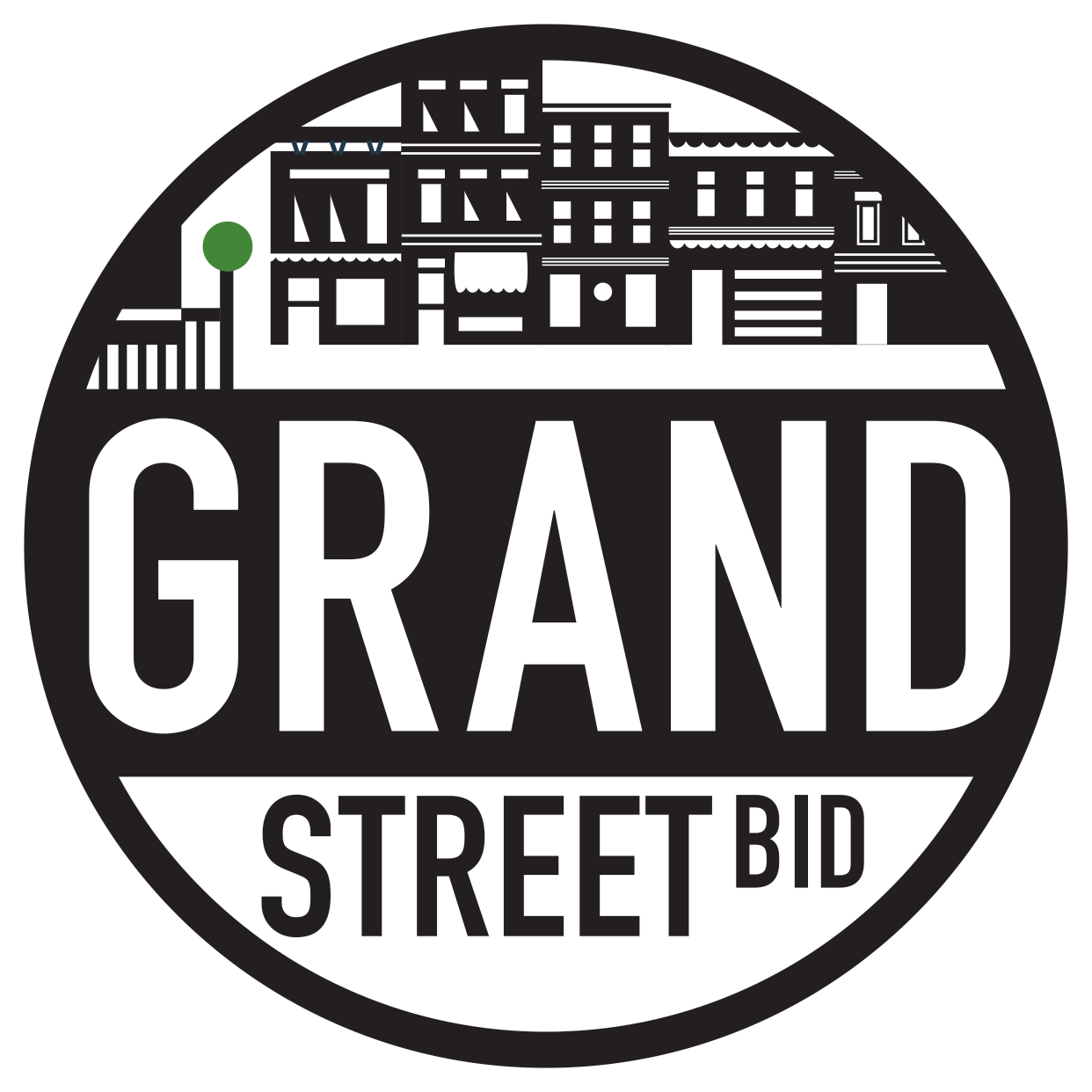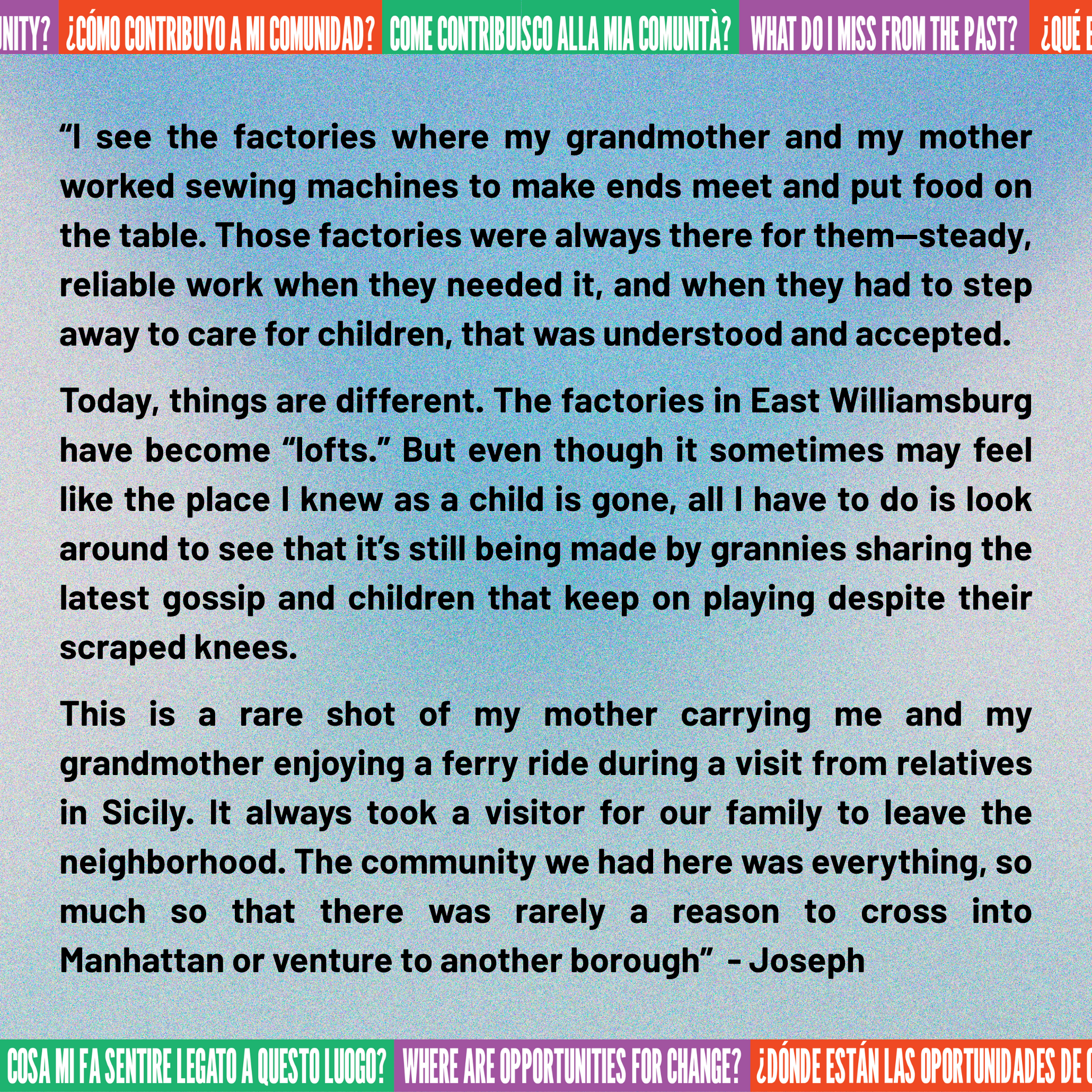The People Make the Place!
¡Las Personas Hacen el Lugar! Le Persone Fanno il Luogo!
The Grand Street BID is proud to present:
The People Make the Place! ¡Las Personas Hacen el Lugar! Le Persone Fanno il Luogo!
“The People Make the Place!” is a temporary, interactive, hybrid installation which aims to engage the community towards a more inclusive vision for its future. The physical installation is set to run from 5/29/25 - 6/30/25 at 246 and 247 Graham Avenue, while the digital installation will continue to be updated here.
Featuring materials submitted by neighborhood partners, and inviting ongoing feedback and storytelling, the multi-media installation frames and reflects (literally and figuratively) the real people of East Williamsburg and their relationship with our shared spaces. It represents a collaborative effort to honor neighborhood history and leaders, a rich culture of co-creating public spaces, and public life through the medium of digital and physical windows.
We want to hear your story! Click the button below to submit a story, image, or vision for the future. Submissions will be collected and shared here, to present an inclusive vision for the future together:
The People make the place!
〰️
¡Las personas hacen el lugar!
〰️
Le persone fanno il luogo!
〰️
The People make the place! 〰️ ¡Las personas hacen el lugar! 〰️ Le persone fanno il luogo! 〰️
installation
The physical installation will live temporarily in storefront space along Graham Avenue, at 246 (Grand Street BID office) and 247 (across the street) featuring three graphic and architectural works. These include a Community-sourced Photo Collage Mural by L&L Studio, the photo series Toñita’s by Sylvia Riveros, and Re: Place (a series of sculptural elements) by Reframe Architecture. The physical installation is set to run from 5/29 - 6/30, with the digital portion living on here.
Photo-Collage Mural, L&L Studio:
L&L Studio worked with Grand Street BID to create a photo-collage mural that invites visitors to meditate on the past, present, and future of the East Williamsburg neighborhood. Spanning four large windows of storefront space along Graham Street, the mural combines images sourced from neighborhood organizations El Puente, Powers Street Garden, and Evergreen Exchange, as well as NYPL and NYC public archives. The artwork is framed by questions in Spanish, Italian and English (three languages historically spoken in the neighborhood) that prompt reflection on how viewers interact with and shape their community:
How do local spaces shape my experience? | ¿Cómo moldean mi experiencia los espacios locales? | In che modo gli spazi locali influenzano la mia esperienza?
Where are opportunities for change? | ¿Dónde están las oportunidades de cambio? |Dove sono le opportunità di cambiamento?
What makes me feel connected here? | ¿Qué me hace sentir conectado aquí? |Cosa mi fa sentire legato a questo luogo?
How do I contribute to my community? | ¿Cómo contribuyo a mi comunidad? | Come contribuisco alla mia comunità?
What do I miss from the past? | ¿Qué extraño del pasado? | Cosa mi manca del passato?
Our team was inspired by speculative design of the 1960s and 1970s that combined photography and architectural renderings to reimagine the relationship between the built environment and culture. As viewers engage with the mural, we hope that they become both observers and participants in the evolving story of the neighborhood, reflecting on its history, transformation, and potential future.







Toñita’s is a photo series by Sylvia Riveros that honors the Caribbean Social Club in Williamsburg and its remarkable founder, Maria Antonia “Toñita” Cay. For over five decades, this space has served as a haven for Puerto Rican and Latin American communities—offering free food, salsa music, and a deep sense of belonging. Through intimate images, the series reflects how people make a place by showing up for one another, sharing joy, and sustaining intergenerational networks of care. Toñita’s bridges generations, cultures, genders, and migration journeys through mutual aid, music, and nourishment.
To learn more, visit: https://www.sylviajulianart.com/
Re: Place, Yalda Keramati | Reframe Architecture:
As part of Design Sprints: Building Creative Capacity (The people make the place!), ReFrame Architecture has designed a series of sculptural elements that emphasize the socio-spatial nature of place by highlighting memory and reflection.
The materiality and geometry of the forms reference the built environment and mimic the folds and volumes of the storefront. It is the reflection of the audience on the sculpture’s surface that brings the installation to life, recognizing the vital role of community in sustaining and transforming the place. It is an invitation for everyone to share their stories and be a part of the collective memory of the neighborhood.
The people make the place!!
〰️
¡Las personas hacen el lugar!
〰️
Le persone fanno il luogo
〰️
The people make the place!! 〰️ ¡Las personas hacen el lugar! 〰️ Le persone fanno il luogo 〰️
Tell us your story! Use the questions below + your experiences being apart of the community to frame your answers. Your stories may be folded into the exhibit at a later date:
How do local spaces shape my experience? | ¿Cómo moldean mi experiencia los espacios locales? | In che modo gli spazi locali influenzano la mia esperienza?
Where are opportunities for change? | ¿Dónde están las oportunidades de cambio? |Dove sono le opportunità di cambiamento?
What makes me feel connected here? | ¿Qué me hace sentir conectado aquí? |Cosa mi fa sentire legato a questo luogo?
How do I contribute to my community? | ¿Cómo contribuyo a mi comunidad? | Come contribuisco alla mia comunità?
What do I miss from the past? | ¿Qué extraño del pasado? | Cosa mi manca del passato?
submissions
Marilyn:
Chaney & Michael:
Joseph:
“My family has a long history here. In Bushwick, I walk past the buildings where my grandfather, fresh off the plane from Palermo with nothing but a dream and a few cigars, raised my dad, aunts, and uncles. Some of those same buildings he later owned, renting them out to other new immigrants, no matter where they came from or what their status was. In East Williamsburg, I see the factories where my grandmother and my mother worked sewing machines to make ends meet and put food on the table. Those factories were always there for them—steady, reliable work when they needed it, and when they had to step away to care for children, that was understood and accepted.
Right across the border, in southern Ridgewood, I remember the stoops where I would play with my cousins and friends. I was lucky enough to experience “stoop culture” as a kid. By then, my grandmother had left factory work and spent her days keeping watch over the street, chatting loudly with anyone willing to listen—or even just passing by. I think she just liked hearing the latest gossip and having people compliment the flowers she took such good care of. If she wasn't at her stoop, I knew I could find her chatting it up at Catania Bakery, did I mention she was not meant to eat sweets?
Today, things are different. The factories in East Williamsburg have become “lofts.” Some of the old apartments have been renovated, meaning they are painted white and rent for more. The stoop where my grandmother once held court now sits quiet and flowerless. With my grandparents gone and many family members having moved away, I’ve become something of a holdout in these parts. But even though it sometimes may feel like the place I knew as a child is gone, all I have to do is look around to see that it’s still being made by grannies sharing the latest gossip and children that keep on playing despite their scraped knees. It's fun to think that they are growing up with their own stories of how their families made this place.
The photo I’ve submitted has nothing to do with "our place" in North Brooklyn/Southern Queens at all, and this is intentional. This is a rare shot of my mother carrying me and my grandmother enjoying a ferry ride during a visit from relatives in Sicily. The ferry ride was just as amusing to them as it was to the family visiting for the first time. It always took a visitor for our family to leave the neighborhood. The community we had here was everything, so much so that there was rarely a reason to cross into Manhattan or venture to another borough.” - Joseph
Produced in partnership with OWLEY Studio.
Join us to celebrate the exhibit at The Grand Street Neighborhood Bash on Monday June 9th at 5:00PM at The Last Call (588 Grand Street). Meet your neighbors, share your stories, and win prizes! Refreshments will be provided to RSVP Attendees.
“The People Make the Place” is part of Design Sprints: Building Creative Capacity, an initiative of Van Alen Institute and the NYC Department of Small Business Services, exploring ways to creatively leverage vacant storefronts.
The installation was made in partnership with branding and digital designers L&L Studio and Reframe Architecture. It features work by artists Sylvia Riveros, Vanesa Álvarez Díaz, Los Muralistas de El Puente, Danielle Mastrion and SON-CORO, SINNED + Ria Burns-Wilder; With submissions by neighborhood partners St. Nick’s Alliance, Evergreen Exchange, El Puente and the Powers Street Garden; with assistance from Absolute Power Gym, Williamsburg Houses and the Brooklyn Public Library.
The physical installation is slated to run through June 2025, with the digital compendium of graphic and story submissions from community members living on this page indefinitely.


























